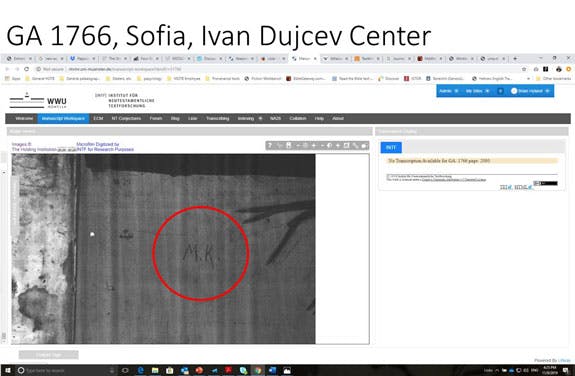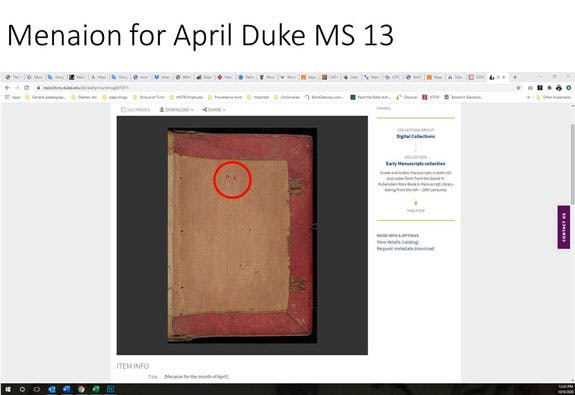March 27, 1917
During World War I, Greece experienced its National Schism—a period when two competing factions of government favored an alliance with different sides in the war. The National Schism caused the Greek government to maintain a de facto unpopular neutrality and hindered its ability to conduct a unified foreign policy. The Bulgarian army took advantage of the situation to seize control of a portion of northeastern Greece known as Eastern Macedonia. Bands of Bulgarian partisans known as komitadji operated freely in this area, causing widespread destruction and loss of life (see Report of the Greek University Commission upon the Atrocities and Devastations Committed by the Bulgarians in Eastern Macedonia [Oxford University Press American Branch: New York, 1919]).
Vladimir Sis accompanied one of these bands, led by Tobor Panitsa, in March 1917 (Figure 1). Sis was a Czech journalist and Slavophile, which brought him under the suspicion of the Austro-Hungarian government. He covered the Balkan Wars for the Czech paper Narodni Listy and settled in Bulgaria. In 1916, he surveyed the libraries of monasteries in northern Greece and learned what treasures they contained. At the time, he presented himself as a professor and archaeologist from the University of Sofia. A letter sent on March 31, 1917, by the prefect of Drama, N. Bacopoulos, to the Greek legation in Sofia describes what happened next. On the night of March 27, 1917, a “band of sixty criminals” forced their way into the Theotokos Eikosiphoinissa Monastery (also known as Kosinitza Monastery) near Drama. The troops beat two of the older monks until they told where everything of value was hidden. They removed 431 manuscripts as well as valuable printed books, precious objects, and 3,000 drachmas in cash. The partisans transported the loot on 24 mules. Although Bacopoulos did not name Sis in his report, other eyewitnesses testified to a postwar commission about his presence in the raid on Kosinitza (source: Rapports et enquêtes de la Commission interalliée sur les violations du droit des gens commises en Macédoine orientale par les armées bulgares [Imprimerie et Libraire Berger-Levrault: Nancy, Paris, Strasbourg, 1919], 286, 293).
Sis and his men also looted the manuscripts from another monastery near Serres. To keep track of where each manuscript came from, Sis made a catalog in which he used abbreviations. Those from Kosinitza received the initials M. K. or K. (Manastir Kosinitsa) and the others the initials M. Cb. Ub. (Manastir Sveti Ivan, “Monastery of St. John,” because the monastery was dedicated to the Holy Precursor, i.e., John the Baptist. Source: Vasilis Katsaros, “Τρια Λανθάνοντα Χειρογραφα της Μονης της Παναγιας Αχειροποιητου του Παγγαιου, της Επονομαζομενης «Κοσινιτσας» ΄η “Εικοσιφοινισσας,” 452). Subsequent research, noted below, found these same initials written inside the manuscripts. After World War I, Sis sold some of the manuscripts in Germany and his wife sold some in Prague. A few of these manuscripts eventually made their way into the collections of American institutions. The Bulgarian government returned some to Greece. Almost 300 manuscripts eventually became the core of holdings of the Ivan Dujcev Center for Slavo-Byzantine Studies in Sofia. According to two articles of the Treaty of Neuilly (1919), Bulgaria should have returned all the manuscripts to Greece:
ARTICLE 125
In addition to the payments mentioned in Article 121, Bulgaria undertakes to return, in accordance with the procedure to be laid down by the Inter-Allied Commission, objects of any nature and securities taken away, seized or sequestrated in the territory invaded in Greece, Roumania or Serbia, in cases in which it is possible to identify them in Bulgarian territory, except in the case of live-stock, which shall be dealt with in accordance with Article 127. . . .
ARTICLE 126
Bulgaria undertakes to seek for and forthwith to return to Greece, Roumania and the Serb-Croat-Slovene State respectively any records or archives or any articles of archaeological, historic or artistic interest which have been taken away from the territories of those countries during the present war. . . .
source: https://wwi.lib.byu.edu/index.php/Section_II_-_PART_VII,_REPARATION,_ARTICLES_121_-_176
Church Actions
In 2015, representatives of the Greek Orthodox Church reached out to four American institutions, asking them to return manuscripts looted from Kosinitza: Princeton University, Duke University, the Morgan Library, and the Lutheran School of Theology at Chicago. All of these institutions had acquired these manuscripts as donations from collectors who had purchased them from antiquarian book dealers without knowledge of the original theft. The Lutheran School of Theology agreed to return its manuscript. At the ceremony held on November 15, 2016, the seminary’s president, James Niemen, formally transferred the manuscript back to the control of the Greek Orthodox Church. The seminary acted in the spirit of ecumenical ties between the Lutherans and the Greek Orthodox Church that had started a half century earlier.
Research at Museum of the Bible
In October 2019, Museum of the Bible associate curator Brian Hyland and Dr. Greg Paulson, a scholar at the University of Muenster’s Institut für Neutestamentliche Textforschung, exchanged a series of emails concerning manuscripts in the Museum Collections. Paulson had asked several questions to update the institute’s database of Greek New Testament manuscripts, known as the Liste (short for Kurzgefaßte Liste der griechischen Handschriften des Neuen Testaments). On October 28, Hyland replied with his answers and a question of his own. He asked if MOTB.MS.000352, a tenth-century Gospel book from southern Italy, was already on the Liste, and, if so, what was its number. To aid in identifying the manuscript, he sent a link to an auction page online.
Paulson replied on November 6, asking if the museum had photos of John 7:53–8:11 (known to scholars as the pericope adulterae, or the story of the woman caught in adultery) so that he could compare them to a description of a possible match in the Liste. The same day, Hyland sent him the photos plus the beginning of John’s Gospel and its end and remarked on the unusual stars that preceded each line of the text (Figures 2, 3, 4, and 5). Paulson’s response the next day set into motion a long investigation. He said that the stars were unusual, which is why he had asked for that passage. “The MS is GA 1429, which has been missing for many years from Kosinitza. I’m attaching the entry for 1429 in Gregory’s Textkritik, which mentions the stars marking the PA (in German: Ehebr)” (Figure 6). He added, “You’re probably aware, but all the manuscripts from Kosinitza were stolen in 1917 and they are requesting them back.” Hyland understood the significance of a manuscript from Kosinitza. He immediately alerted Jeffrey Kloha, chief curatorial officer at Museum of the Bible, and started an in-depth investigation into the manuscript’s provenance.
Dealer records at Museum of the Bible established that the Green Collection of Oklahoma City purchased the manuscript from Christie’s at auction on June 8, 2011. The manuscript had previously been sold by H. P. Kraus, a well-known New York antiquarian dealer, in 1958. The Christie’s sale information referenced that previous sale, but provided no other modern ownership history. The Green Collection donated it to Museum of the Bible in 2014.
Paulson had used the starred lines from the Gospel of John to show that this was Kosinitza Manuscript 220 (GA 1429), but Hyland found further confirmation that it had been looted on March 27, 1917. Inside the back cover, written in red pencil on the bare wood, were the initials M. K. (Figure 7). Acting on a hunch that they referred to the Kosinitza Monastery, he looked at photos of manuscripts in the Ivan Dujcev Center for Slavo-Byzantine Studies in Sofia available on the website of the Liste. Thirteen manuscripts had images of the back cover that contained similar initials:
- GA 1425
- GA 1428
- GA 1766
- GA 1779
- GA 1781
- GA 1783
- GA 1784
- GA 1787
- GA 1789
- GA 1790
- GA 1791
- GA 1792
- GA 1794
A fourteenth manuscript containing the initials was GA 1795. It had formerly been in Sofia, but is now Manuscript 714 in the collection of the Morgan Library. Two of Duke’s manuscripts, MS 13 and MS 60 (GA 1423), contain the initials, although they are partially erased from MS 60. A seventeenth manuscript with the initials is Gr. 73 in the library of Uppsala University (Figures 8, 9, and 10). Later research led to the article by Vasilis Katsaros (above) that indicated Sis had used this abbreviation in his catalog. It was logical to infer that the initials were put in the manuscripts near the time that they were looted, since in each manuscript the initials seem to be in the same hand and the colored photos indicate that a red pencil was used.
As a timeline of Eikosiphoinissa MS 220’s history emerged, there were some gaps, but known history of the manuscripts sought by the Greek Orthodox Church gave clues as to where the manuscript might have been.
Eikosiphoinissa MS 220’s Timeline
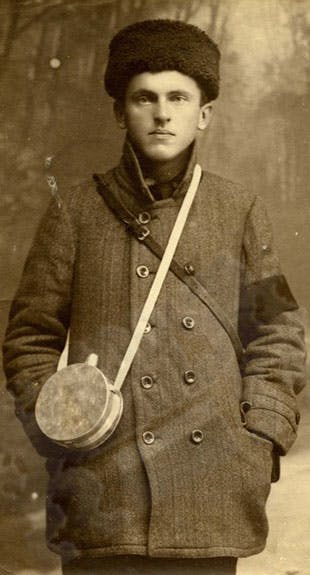
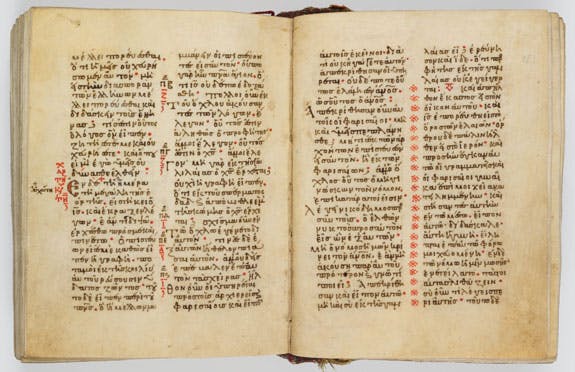

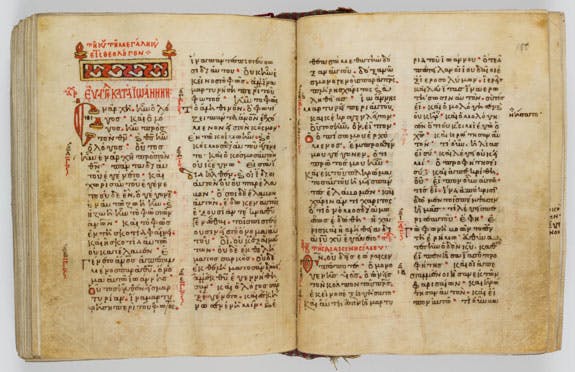
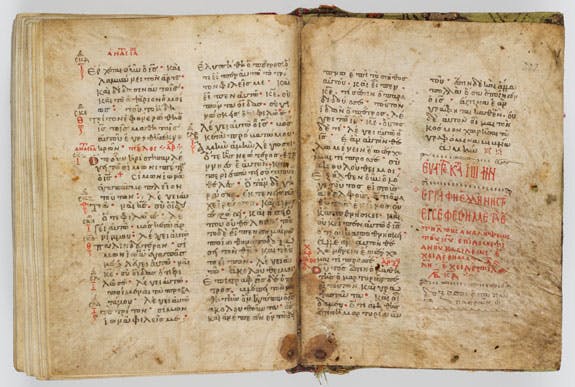
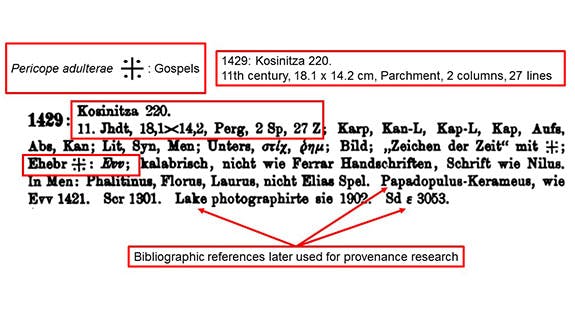
Figure 6

Annotated extract from Caspar René Gregory, Textkritik des Neuen Testamentes, Bd.3 (Leipzig: J.C. Hinrichs’sche Buchhandlung, 1909), p. 1146
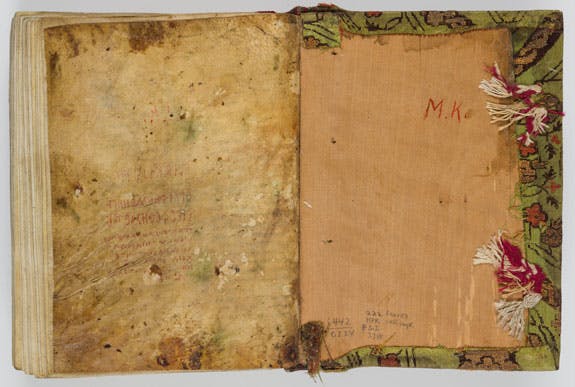
Figure 7

Inside back cover of Kosinitza manuscript 220, with “M.K.” notation. The lead pencil marks are notes from the H.P. Kraus sale in 1958.
